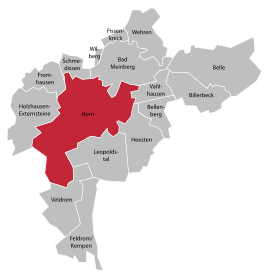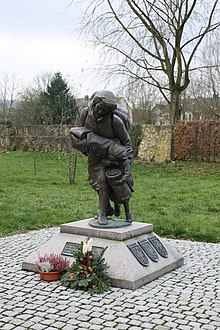Horn (Horn-Bad Meinberg)
|
horn
City of Horn-Bad Meinberg
Coordinates: 51 ° 52 ′ 22 " N , 8 ° 56 ′ 40" E
|
|
|---|---|
| Height : | 218 m |
| Residents : | 7018 (Dec. 31, 2004) |
| Incorporation : | January 1, 1970 |
| Incorporated into: | Bad Meinberg-Horn |
|
Location of Horn in Horn-Bad Meinberg
|
|
Horn is a district of the town of Horn-Bad Meinberg in the Lippe district in North Rhine-Westphalia . According to the Detmold Act , the formerly independent municipality was incorporated into the town of Horn-Bad Meinberg in 1970.
history
In the forest southwest of Horn there is an old settlement. The field names "Auf der Hausstelle" and "Am Hüttenschlag" in the city forest between Kartoffelberg and Krebsbachtal indicate this. According to tradition, it was a large courtyard, which was fenced in with hurdles, a wickerwork of rods and sticks (Low German hearing) and was called "in the hearing". What was outside the enclosure was called "for (before) the hearing" (before the Horn), from which the name Horn could later have originated.
The town of Horn is considered to be the first town founded by Bernhard III, Edler Herr zur Lippe and was therefore founded after 1230. It was placed over an older existing church village. The first documentary evidence dates from 1248 and mentions their Lippstadt town charter . This makes Horn the third oldest city founded by the Noble Lords of the Lippe and, after Lippstadt's departure from the territory, after Lemgo, the second oldest city of Lippe . With Blomberg , Horn was on the old Kölnische Landstrasse from Cologne to Hameln , which partly corresponds to today's Bundesstrasse 1 , and secured its pass over the Egge Mountains . As with other Lippe cities, the road network was laid out according to plan with a central street, two further longitudinal streets (Heerstraße and Burgstraße / Pfuhlstraße) and a cross street (Nordstraße / Leopoldstaler Straße). The oldest buildings in the city include the Gothic parish church , Horn Castle , the old town hall, the Kotzenbergsche Hof , the former Burgmannenhof, the former Calandshaus, the former poor house, the former administrative building.
In the witch hunts in Horn from 1554 to 1661, 47 cases of witchcraft and sorcery are documented. At least 24 people were executed in the witch trials , some died in custody, and many fates are unknown.

Horn Castle was later used as a retirement home by several widows of the Lippe family, most recently from 1666–1673 by Countess Amalie zur Lippe. Armed conflicts over the city took place in particular during the Soest feud (1444–1449) and during the Thirty Years' War (1618–1648). In 1864, large parts of the city center were destroyed in a fire; 60 houses fell victim to the flames. The new neo-Gothic town hall built in 1864 is a successor to the town hall that was destroyed in the great city fire.
A rail connection for the town of Horn has existed since 1895; the station built outside the city center in the direction of Bad Meinberg is on the Detmold - Altenbeken line .
Between 1912 and 1952 it was even possible to use the tram . In its heyday it led from Horn to the northwest to Detmold and from there to the Detmold districts of Pivitsheide , Berlebeck and Heiligenkirchen . To the southwest you could drive via Schlangen and Bad Lippspringe to Paderborn . At times this route even ran right through the middle of the Externsteine . You can still see traces of the overhead line fastening on the rocks. In a north-easterly direction, the tram ran via Bad Meinberg to Blomberg . The tram was operated by Paderborner Elektrizitätswerke und Straßenbahn AG , or PESAG for short, until 1952 .
On January 1, 1970, Horn was incorporated into the new municipality of Bad Meinberg-Horn . This was renamed Horn-Bad Meinberg on September 10, 1970 .
Moorlage settlement
To the east of the horn was at the beginning World War II the settlement Moor location . The reason was the relocation of the village of Haustenbeck in the Senne , which had to give way to the Senne military training area . A large part of the village community moved to Horn, where the Künnemeyer company was looking for workers. The farmers received farms from the RUGES resettlement society . On February 18, 1938, the first proposal to build a closed settlement came. About forty families moved to Horn.
The project was planned by the Detmold district building authority. Four house types were available. The residents had a say in the interior and sanitary facilities. Each house was equipped with an indoor toilet and bathing facility. The settlement was to consist of forty houses that were to be built close together. One plot was 1–3 bushels of seed (1 SS = 1717 m²) with enough land for arable farming and space for small livestock farming. At the time, one square meter cost 0.40 Reichsmarks . The construction price of the one- and two-family houses with stables was between 8,000 RM and 15,000 RM.
Measurements were made in 1938 and the Moorlage settlement was classified as "important to the war effort". At the end of January 1939 it was decided that 31 single-family and 13 two-family houses would be built. The date of resettlement was November 5, 1939. A rectangular chessboard settlement was created in which the citizens could provide for themselves with cattle and fields. To make the settlement look a little more relaxed, the gables were staggered, the main street was wider and planted with trees on both sides and footpaths were also laid out.
The moor was to be connected to the Horner water pipe network and the power supply was provided by PESAG . The building site was the former Hudegelände . When work began in January 1939, the Lippische Staatszeitung even wrote an article about the settlement project. But winter hampered construction work and there was a lack of materials such as iron and steel. At the end of August 1939 the first Haustenbeck arrived, Mayor Wilhelm Mehrmann . On September 1, 1939, preparations for the move failed because the war began.
In 1989, 42 of the 44 settlement houses were still owned by the families who built them. At the end of 1989 the moorland celebrated its 50th anniversary. For this anniversary a memorial stone was erected with the inscription: "50 years of moorland / In memory of the resettlement of Haustenbeck."
Culture and sights
Buildings
- Evangelical Church Horn , formerly St. John the Baptist. The two-bay, three-nave hall church with west tower and polygonal choir was built in the last quarter of the 15th century. The tower is likely to date from the 12th century, making it the oldest known structure in Horn. In 1819 the roof of the church and the tower were destroyed after a lightning strike. It was not until 1826 that the current Welsh tower dome could be completed. The spaciousinterior, spannedby ribbed vaults , looks very compact. The vaults rest on two mighty round pillars . The furnishings include a font from 1589 and an organ prospect from the 17th century. In the choir there is achoir stallswith Gothic carvings from the late 15th century, which were reworked in the 19th century. The epitaph of Cordt von Mengerssen († 1561) has been attached tothe southeast wall of the aisle since 1859. It was originally set up in the choir area. In the nave there are five chandeliers that were commissioned by the town of Horn and the brewers' guild from a Nuremberg goldsmith in 1708.
- The former Horn Castle (local history museum) is located directly on the city wall . The existing facility is likely to have been built during the founding of the city and was evidently expanded in 1348. It is an angular two-storey building above a high basement that protrudes slightly into the former city moat. It was heavily rebuilt between 1656 and 1659. During this time, the east wing was apparently added and the stairwell was installed. A new portal was installed on the front. The upper part of the tower, which was originally crowned by a curved hood, was later demolished due to its dilapidation. In the course of the restoration work carried out between 1983 and 1989, the tower was given its upper floors and a new roof. The former castle barn, a plastered building with a crooked hip roof , was built in 1744.
- Town hall . The stately neo-Gothic building was built in 1865-66 by the contractor and architect Wilhelm Lakemeier from Steinheim (Westphalia) after the previous building had been destroyed by fire two years earlier. Originally two-winged, it was expanded in 1956 with rear extensions. The front of the market, designed as a front, shows two risalites , which are crowned by triangular gables decorated with pinnacles . At the northeast corner facing Mittelstrasse there is a four-storey polygonal corner tower, which is closed off by a low balustrade .
- Courtyard of Kotzenberg (Hotel Vialon). The two-storey solid structure consisting of two wings was built around 1616. Heinrich Baumhauer could beconsidered as a master builderdue to the similar individual shapes at the Paderborn town hall. On the market side there is a pretty portal, which is marked 1680.
Memorials
The monument with the scene of a fleeing mother with two children stands at Horn Castle. The coats of arms of the former eastern provinces of Germany are depicted on the base. The monument stands in memory of the suffering of the displaced people. A united Europe is named as a solution on a plaque on the monument.
See also
literature
- CW Isermann: News and notes about the town of Horn and its inhabitants from the earliest times to the present. New arrangement, Detmold 1890. Edited by Hans Vennefrohne, Horn-Bad Meinberg 1977
- Dirk Hillebrand, Malte Brinkmann: The problem of urban erosion. Analysis of the city image and the retail trade to develop countermeasures using the example of the city of Horn. Diploma thesis, University of Paderborn 1993
- Hans Vennefrohne: The great fire in Horn in 1864 and its consequences. Horn-Bad Meinberg 1994 (Writings of the Horn Heimatverein, No. 2)
- City history Horn 1248-1998. Ed. V. Jens Buchner i. A. of the city of Horn-Bad Meinberg. Horn-Bad Meinberg 1997. ISBN 3-922417-13-2
Web links
- Horn (Horn-Bad Meinberg) in the Westphalia Cultural Atlas
Individual evidence
- ^ CW Isermann: News from the city of Horn ..., edited by. H. Vennefrohne, Horn-Bad Meinberg 1977, p. 1
- ↑ Jens Buchner: The "old Horn": Historical city tour in Horn before the great fire in 1864. In: StadtGeschichte Horn 1248–1998, p. 65
- ↑ Jens Buchner (1998), p. 67
- ↑ Ingrid Ahrend-Schulte: Sorceresses in the City of Horn (1554-1603) , Magical Culture and Witch Hunting in the Early Modern Age, History and Gender, Volume 21, Frankfurt / Main, New York 1997, pp. 244f.
- ↑ Martin Bünermann: The communities of the first reorganization program in North Rhine-Westphalia . Deutscher Gemeindeverlag, Cologne 1970, p. 106 .
- ^ Federal Statistical Office (ed.): Historical municipality directory for the Federal Republic of Germany. Name, border and key number changes in municipalities, counties and administrative districts from May 27, 1970 to December 31, 1982 . W. Kohlhammer, Stuttgart / Mainz 1983, ISBN 3-17-003263-1 , p. 321 .
- ^ Hans-Georg Ippig: Own monument. In: Preußische Allgemeine Zeitung of December 14, 2013, p. 12, readers' forum.







